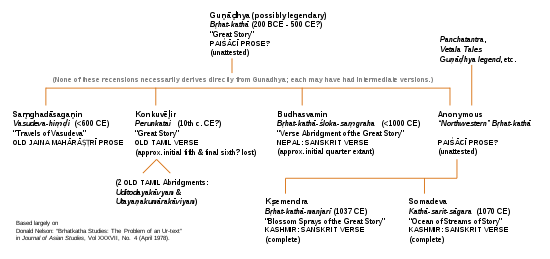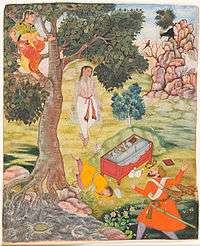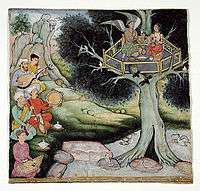Kathasaritsagara
|
A 16th century folio from an Indian retelling of the Kathasaritsagara |
The Kathāsaritsāgara ("Ocean of the Streams of Stories") is a famous 11th-century collection of Indian legends, fairy tales and folk tales as retold in Sanskrit by a Shaiva named Somadeva.
Kathasaritsagara is said to have been adopted from Guṇāḍhya's Brihatkatha, which was written in a poorly-understood language known as Paiśācī. The work is no longer extant but several later adaptations — the Kathasaritsagara, Brihatkathamanjari and Bṛhatkathāślokasaṃgraha. However, none of these recensions necessarily derives directly from Gunadhya, each may have an intermediate versions. Scholars compare Guṇāḍhya with Vyasa and Valmiki even though he did not write the now long-lost Brihatkatha in Sanskrit. Presently available are its two Sanskrit recensions, the Brihatkathamanjari by Kshemendra and the Kathasaritsagara by Somadeva.
Content


The work consists of 18 books of 124 chapters and approximately 22,000 ślokas (distichs) in addition to prose sections.[1] The śloka consists of 2 half-verses of 16 syllables each. Thus, syllabically, the Kathāsaritsāgara is approximately equal to 66,000 lines of iambic pentameter; by comparison, John Milton's Paradise Lost weighs in at 10,565 lines. All this pales in comparison to the (presumably legendary) 700,000 ślokas of the lost original Brihatkatha. The principal tale is the narrative of the adventures of Naravahanadatta, son of the legendary king Udayana. A large number of tales are built around this central story, making it the largest existing collection of Indian tales. It also contains early recensions of the Panchatantra in Book 10; and the Vetālapañcaviṃśati, or Baital Pachisi, in Book 12.
The Kathāsaritsāgara is generally believed to derive from Gunadhya's lost Brihatkatha written in the lost Paisaci dialect. But the Kashmirian (or "Northwestern") Brihatkatha that Somadeva adapted may be quite different from the Paisaci ur-text, as at least 5 apparent descendants of Gunadhya's work exist — all quite different in form and content, the best-known (after the Kathāsaritsāgara itself) probably being the Bṛhatkathāślokasaṃgraha of Budhasvamin from Nepal. Like the Panchatantra, tales from the Kathāsaritsāgara (or its related versions) travelled to many parts of the world.
Translations
The only complete translation into English[2] is by Charles Henry Tawney (1837–1922), published in two volumes (1,300 pages in all) in 1880 and 1884. This was greatly expanded, with additional notes and remarks comparing stories from different cultures, by Norman Mosley Penzer, and published in ten volumes ("privately printed for subscribers only") in 1924-1928.
Another translation was to be published in seven volumes by the Clay Sanskrit Library, translated by Sir James Mallinson, but it published only two volumes, reaching up to canto 6.8, before the publisher ended operations.
Influence
The book was a favourite of scholar of Buddhism Herbert V. Guenther, according to Jodi Reneé Lang, Ph.D.[3] The idea of a sea of stories shows up in the Salman Rushdie's Haroun and the Sea of Stories.


See also
Notes
- ↑ Penzer 1924 Vol I, p xxxi.
- ↑ And, at least as of the 1960s, the only complete translation into any European language. (Igor D. Serebryakov: A Few Thoughts on the Katha Sarit Sagara pp a-b in Tawney (1880, rpt. 1993 New Delhi: Munshiram Manoharlal).
- ↑ "Jodi Reneé Lang, Ph.D.: Herbert Guenther, The Man".
References
- Sanskrit text
- Pandit Durgāprasāda; Kāśīnātha Pāṇḍuraṅga Paraba, eds. (1889), The Kathâsaritsâgara of Somadevabhatta, The Nirnaya-Sâgara Press
- Translations
- C. H. Tawney (1880), The Kathá sarit ságara; or, Ocean of the streams of story: Vol I, Vol II on the Internet Archive
- N. M. Penzer (1924), The ocean of story, being C.H. Tawney's translation of Somadeva's Katha sarit sagara (or Ocean of streams of story): Vol I, Vol II, Vol III, Vol IV, Vol V, Vol VI, Vol VII, Vol VIII, Vol IX, Vol X on the Internet Archive
- A. R. Krishnashastry, Kathaamrita (1952) (Kannada: ಕಥಾಮೃತ), Geetha Book House, K.R. Circle, Mysore 570 001, India
- Sir James Mallinson (2009), The Ocean of the Rivers of Story, Clay Sanskrit Library: Vol 1 of 7, Vol 2 of 7
- Arshia Sattar (1997), Tales from the Kathasaritsagara includes key selections from the Kathasaritsagara. Published by Penguin Classics.
- Radhavallabh Tripathi, Katha Sarit Sagar (Hindi). National Book Trust. ISBN 9788123714318.
External links
- Online HTML ebook of The Ocean of Story (kathasaritsagara), volume 1-9, proofread, including thousands of notes and extra appendixes.
- Works by Somadeva Bhatta at Project Gutenberg
- Works by or about Somadeva Bhatta at Internet Archive
- Works by or about Kathasaritsagara at Internet Archive
- Works by Kathasaritsagara at LibriVox (public domain audiobooks)

- Somadeva Bhaṭṭa at Library of Congress Authorities, with 43 catalogue records
- Works by or about Somadeva Bhaṭṭa in libraries (WorldCat catalog)